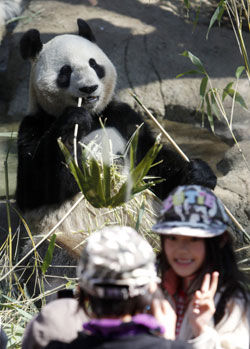Pandas may find traveling hard to bear
Updated: 2012-01-09 08:22
By Jiang Xueqing (China Daily)
|
||||||||
Stress of flying
Among all factors that would stress the pandas, long-distance travel is the most significant, said Li Mingxi, an expert at the Chengdu base.
In September 2007, Li and a colleague escorted pandas Bing Xing and Hua Zuiba to Madrid Zoo in Spain. They took off in Chengdu on a TNT cargo aircraft for a transfer in Shanghai.
Because they had already cleared customs in Chengdu, they could not leave the Shanghai airport. The Chinese experts put the caged pandas in a relatively quiet corner of the freight yard, but the loud noises of cargo loading and planes taking off and landing disturbed the animals.
Bing Xing and Hua Zuiba became nervous and restless, pacing their cages for half the night. Li and his colleague were prepared, with 200 kg of fresh bamboo shoots. The food comforted the pandas, and they fell asleep around 4 am. They took off for Madrid a few hours later.
|
|
After more than 30 hours of travel, the pair finally arrived at the zoo. The passageways were too narrow, so a crane was used to lift them into their outdoor activity fields. From there, the pandas moved to the indoor enclosures.
Hua Zuiba remained nervous for several months. She clasped her limbs tightly even when she was eating, rather than spreading out her arms and legs comfortably.
"Transportation - especially transfer - has a huge impact on pandas," Li said. "If we take a direct flight, it will be much less stressful. The more twists and turns they experience, the louder noises they suffer, the bigger the impact.
"In an ideal world, pandas should be closed from the public upon their arrival in another country and not receive any form of visit, reception or interview. After several days of rest, they will adapt to the new environment very quickly," he said.
Custom containers
The cages for panda transportation are specially designed and, usually, are made by panda experts. In the case of Bing Xing and Hua Zuiba, the pair bound for Madrid, the Chinese experts sealed three sides of the cage with steel plates to prevent people from having contact with the animals and provided many holes on the side plates for ventilation.
For Wang Wang and Funi's trip to Australia, the cage made in China was 1.66 meters long, 1.2 meters high and 1 meter wide. Its main frame was steel, while its baseboard was plastic for warmth. The light inside the cage was kept low to quiet the pandas.
People could not touch the pandas from the outside, nor could the pandas reach out to injure people. Animal keepers and veterinarians could watch the animals at any time from an observation hole that was convenient to open and close. A tray was installed at the bottom of the cage to collect urine, which was soaked up by absorbent material.
Sometimes, containers provided by well-known shipping companies are used for panda transportation.
Tian Tian and Yang Guang traveled in two custom-built containers provided by FedEx Express, which flew the pandas nonstop from Chengdu to Edinburgh on a chartered Boeing 777F, a flight called the FedEx Panda Express. Such containers will also be used to send the pandas to France, Li said.
Write the reporter at jiangxueqing@chinadaily.com.cn

 Relief reaches isolated village
Relief reaches isolated village
 Rainfall poses new threats to quake-hit region
Rainfall poses new threats to quake-hit region
 Funerals begin for Boston bombing victims
Funerals begin for Boston bombing victims
 Quake takeaway from China's Air Force
Quake takeaway from China's Air Force
 Obama celebrates young inventors at science fair
Obama celebrates young inventors at science fair
 Earth Day marked around the world
Earth Day marked around the world
 Volunteer team helping students find sense of normalcy
Volunteer team helping students find sense of normalcy
 Ethnic groups quick to join rescue efforts
Ethnic groups quick to join rescue efforts
Most Viewed
Editor's Picks

|

|

|

|

|

|
Today's Top News
Health new priority for quake zone
Xi meets US top military officer
Japan's boats driven out of Diaoyu
China mulls online shopping legislation
Bird flu death toll rises to 22
Putin appoints new ambassador to China
Japanese ships blocked from Diaoyu Islands
Inspired by Guan, more Chinese pick up golf
US Weekly

|

|







